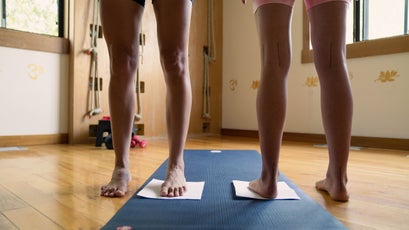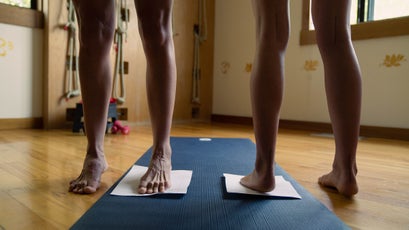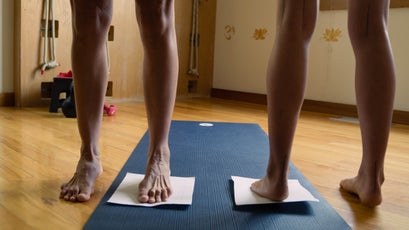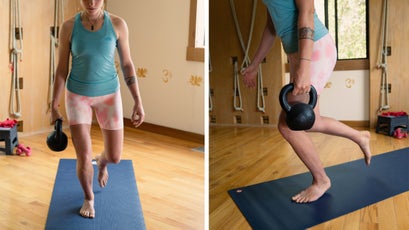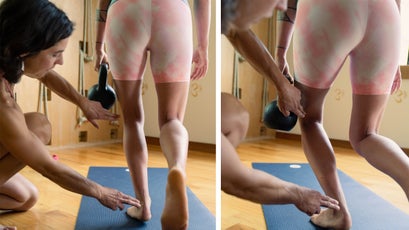Our bodies are a bit like buildings: the physical structure is constantly resisting gravity. Now, imagine a skyscraper with a collapsed foundationÔÇöitÔÇÖs not just the ground floors that are compromised: the entire architecture is at stake. Our feet and ankles┬áare our foundation, and weaknesses here can lead to a host of issues elsewhere. Fallen archesÔÇöalso known as overpronationÔÇöare a common source of local foot and ankle issues and can lead to issues further upstream, in the knees, hips, and spine.
Fixing Overpronation Is An Inside Job
Overpronation happens when the vertical, curved shape of our natural foot arch collapses while weight bearing. The structure of the hips naturally inclines the body to collapsed arches: the femur bones angle inward, from a wide pelvis to a more narrow base of support at the feet, exposing our bodies to forces that we have to combat with postural strength. Additionally, genetics, muscle and connective tissue weakness, alignment, and gait mechanics can all lead to fallen arches. Symptoms vary but include obvious pain, tendinitis, and numbness at the foot and ankle as well as more sneaky complaints up the kinetic chain like knee and hip pain.
Typically, overpronation goes hand-in-hand with excessive internal rotation of the femurs, which you can see in the video below. You can check out your alignment by referencing a couple of anatomical landmarks: the vertical tendons of the hamstring muscles behind your knees and the achilles tendons behind your ankles. These should be oriented straight back. With excessive internal rotation, you might see them angled slightly outward.
One common solution to overpronation is supportive shoe insoles, which fill the space of the arch and physically prevent it from collapsing. But that doesnÔÇÖt address why the arch is falling in the first place. The hip muscles, specifically the external rotators, sit under the glute muscles and help reinforce the neutral position of the femurs and lower legs. Activating and strengthening these muscles supports good alignment through the lower body and can help naturally lift and support the arches. Over time, the human bodyÔÇÖs intrinsic capacity to self-repair weak muscle, nerves, and connective tissue (including bone, ligaments, tendons, and fascia) allows us to make lasting changes to our structure. The below exercises will help you identify and maintain alignment through consistent strengthening and mobility work.
The Moves
Deep Hip External Rotator Activation: The Fingertip Lift
What it does: Engages the external hip rotators to align the anatomical landmarks we identified above and lift the arches. Helps build strength, elasticity, and resilience in the feet and ankles, knees, and hips.
How to do it: Stand barefoot and imagine that you have two flat discs under both of your feet. Engage the deep hip rotators by ÔÇśspinning the discsÔÇÖ without moving your feet. This will feel like a gentle twist of your left hip counterclockwise and your right hip clockwise. Your femurs should spin open into external rotation. Relax your quadsÔÇöthe effort should be coming from your hips. Maintain even pressure through the toes and the balls of your feet.
Your foot position should remain static except for a noticeable lift of the arch, enough to allow you to tuck your fingertips underneath your arch close to the front of your heel. Just go far enough to orient those tendon landmarks┬áin their ideal positionÔÇöotherwise, you can overcorrect into supination, putting excessive weight on the outside of the foot and lifting off of the big toes. You may want the help of a mirror or a friend at first.
Volume: Do three to five repetitions of activating and relaxing. Perform this alignment several times per day, or whenever you find yourself standing.
The following moves are part of the Ground Force series from , where I work as a coach. They will help your body maintain the above structural alignments, and strengthen your foot and ankle complex all the way up to your hips, building a solid foundation for movement. Ditch your shoes for these exercises to get acquainted with muscles and connections in your feet and legs that you may have never felt before.
Foot Activation
What it does: Repairs the neuromuscular circuits from feet to brain, by activating dormant muscles of the foot and ankle.
How to do it: Stand barefoot with a corrected arch position. Then, activate the muscles of both feet by gripping the ground with your toes. It should feel like a quick snap that elevates your heels about a half-inch and brings you into an active forefoot stance. Keep your knees straight and soft, and avoid performing a calf raiseÔÇöthis should all originate with the feet. The gripping action should engage the achilles tendons, the calf muscles, the hamstrings, and the glutes. If youÔÇÖre having a hard time performing this move, try placing a flat sheet of paper under your feet and attempting to scrunch it.
Volume: Perform one to three sets of five to fifteen repetitions. Perform this move often throughout the week.
Single Leg Forefoot Isometric Hold
What it does: Rebuilds the connective tissues of the foot and ankle, strengthens muscles from feet to trunk.
How to do it: Stand on one leg, shift your weight into your forefoot, curl your toes to grip the ground, and then lift your heel. Hold for 30 to 40 seconds. Use your free fingertips against a wall for balance if needed. You should feel the work in your feet, achilles tendons, calf muscles, and thighs. Your priority here is to keep your arch and your hips stable. Start with bodyweight, and add load in the form of a dumbbell or kettlebell if it feels too easy. If you opt to use weight, hold it in the same hand as the standing leg. Stop if you have any pain.
Volume: Perform one to three 30- to 40-second holds, resting for two minutes in between. Repeat two to four days a week.
Double-Leg Hop in Ground Force Foot Position
What it does: Promotes bone health, elasticity, and appropriate foot and ankle stiffness.
How to do it: Assume your active forefoot position with corrected arches. Stiffen your ankle joint, holding it firm, close to a right angle, and begin hopping with low amplitude. In this move you are attempting to train your feet and legs to endure quick dynamic forces in the active forefoot position so that you can better perform fast movements like running and bounding without overpronation. You also may begin to feel the springiness of your plantar fascia and achilles tendons that allows us to hop, jump, and run with elasticity. Adjust speed, height, and amplitude over time, as tolerated. Stop if you have any pain or fatigue.
Volume: Hop for 10 to 30 seconds, then rest for a minute. Repeat one to three times. Do this between two and five times per week.
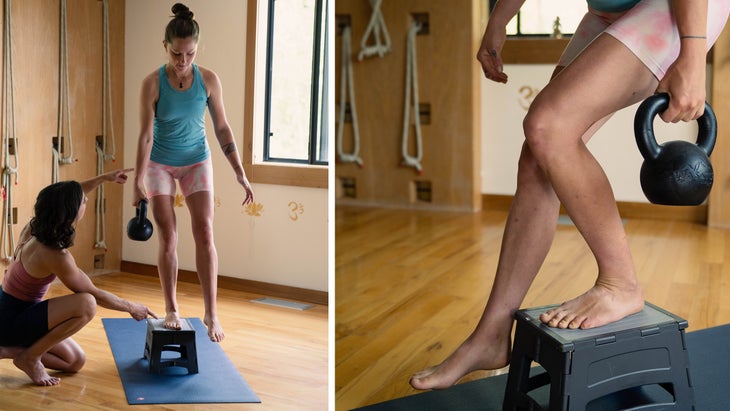
Single-Leg Squat on Box or Step
What it does: Builds strength and power by improving the integrity of your arches and alignment, and challenges your single-leg squat control and depth.
How to do it: YouÔÇÖll need a step and a kettlebell or free weight for this move. Stand with one foot on the step, knee bent, and the other foot dangling in mid-air in front of you. Your standing foot should be flat, with corrected arch position. Hold the weight plumb under your shoulder and next to your hip on your standing-leg side. Hold your shoulders secure and your trunk upright. As you squat, only go as low as you can while maintaining alignment through the hip, knee, and arch. Then, stay low and pulse deeper with each repetition. Use your free fingertips against a wall for balance if needed. Choose a weight that allows you to perform six to eight repetitions without sacrificing your form. Good form is the priority, and you should feel this in the deep hip rotators, glutes, and hamstrings less than in your quads. Stop if you have any pain.
Volume: Two to five sets of six to eight repetitions, with two minutes of rest in between.


